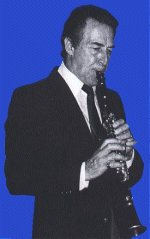"A
One Night Stand with
the Big Bands"
(As originally broadcast on WTIC, Hartford, CT)

Click on the link below to hear
Program 29 - Buddy DeFranco - October, 1973

Note:
This is a large file; it may take a long time to load.
You can save the file to your hard drive by placing your curser over the link,
pressing the right mouse button, and selecting "save target as . . ."
With a T1, cable modem, or DSL this might take 1-3 minutes.
Program 29 - Buddy DeFranco - October, 1973
Return to Log of Programs
(As originally broadcast on WTIC, Hartford, CT)

Click on the link below to hear
Program 29 - Buddy DeFranco - October, 1973

| Buddy
DeFranco is generally regarded as the greatest jazz clarinetist of all
time. Buddy DeFranco began playing professionally in 1935, at the age of only 12, helping his blind father support a poor family in South Philadelphia. After attending the Mastbaum School and receiving classical training, Buddy broke into the jazz music business when he won a national Tommy Dorsey talent contest. By 1939, Buddy was on the road with the Johnny "Scat" Davis big band and spent the next several years moving from band to band. Finally, in 1944, Tommy Dorsey himself recruited the gifted clarinetist, and thus began Buddy's four year stint with the most popular dance band of the era. Although the big band provided a perfect forum for Buddy to showcase his talent on the clarinet, the "king" of instruments during the swing era, Buddy grew restless with the limitations of popular music and Tommy Dorsey's rigid interpretations of hit songs. In 1948, Dorsey had "the talk" with Buddy. "Everybody that listens to something hears it differently from their own perspective. And you can't please everyone. Don't even try. Please yourself first and then try to please those people around you that you feel know what you're doing." -- Buddy DeFranco The bebop revolution of the 1940s enabled Buddy to break looses from the confines of swing and granted him "the freedom to float" he desired. The challenge was clear: from "king" of the swing instruments, the clarinet was not well suited to bebop, due to its temperamental nature. Buddy eventually got recording dates with many of the bebop legends plus a steady spot in the Count Basie septet. While the Basie gig was prestigious within the jazz community, trumpeter and fellow band member Clark Terry recalled the interesting "reverse racism" Buddy encountered for being the only white member of the septet. The 1950s were a prolific time for Buddy. He formed his own quartet with drummer Art Blakey, pianist Kenny Drew, and bassist Eugene Wright. In 1954, he embraced the opportunity to play a European tour with the spectacular Billie Holiday. Through producer Norman Granz, Buddy was paired with his boyhood idol, pianist Art Tatum, and was featured on the Jazz at the Philharmonic recordings. Despite his success, Buddy struggled with the only major criticism of his long career, a column by jazz writer Nat Hentoff. When rock and roll began to steal the jazz's thunder towards the end of the 1950s, Buddy made ends meet with studio work for film and television until he was invited to lead the Glenn Miller Orchestra in 1966. During the subsequent period, Buddy met and married his wife Joyce, and joined forces musically with vibraphonist Terry Gibbs. Gibbs and Defranco formed a dynamic pair, complimenting each other musically and personally. Buddy Defranco continues to progress with time, influencing young clarinetists with his gentle, generous personality and his ceaseless energy for experimentation. Update: Buddy DeFranco died on December 24, 2014, at age 91. Here is the obit from the Washington Post. And here is the obit from the BBC. |
You can save the file to your hard drive by placing your curser over the link,
pressing the right mouse button, and selecting "save target as . . ."
With a T1, cable modem, or DSL this might take 1-3 minutes.
Program 29 - Buddy DeFranco - October, 1973
Return to Log of Programs